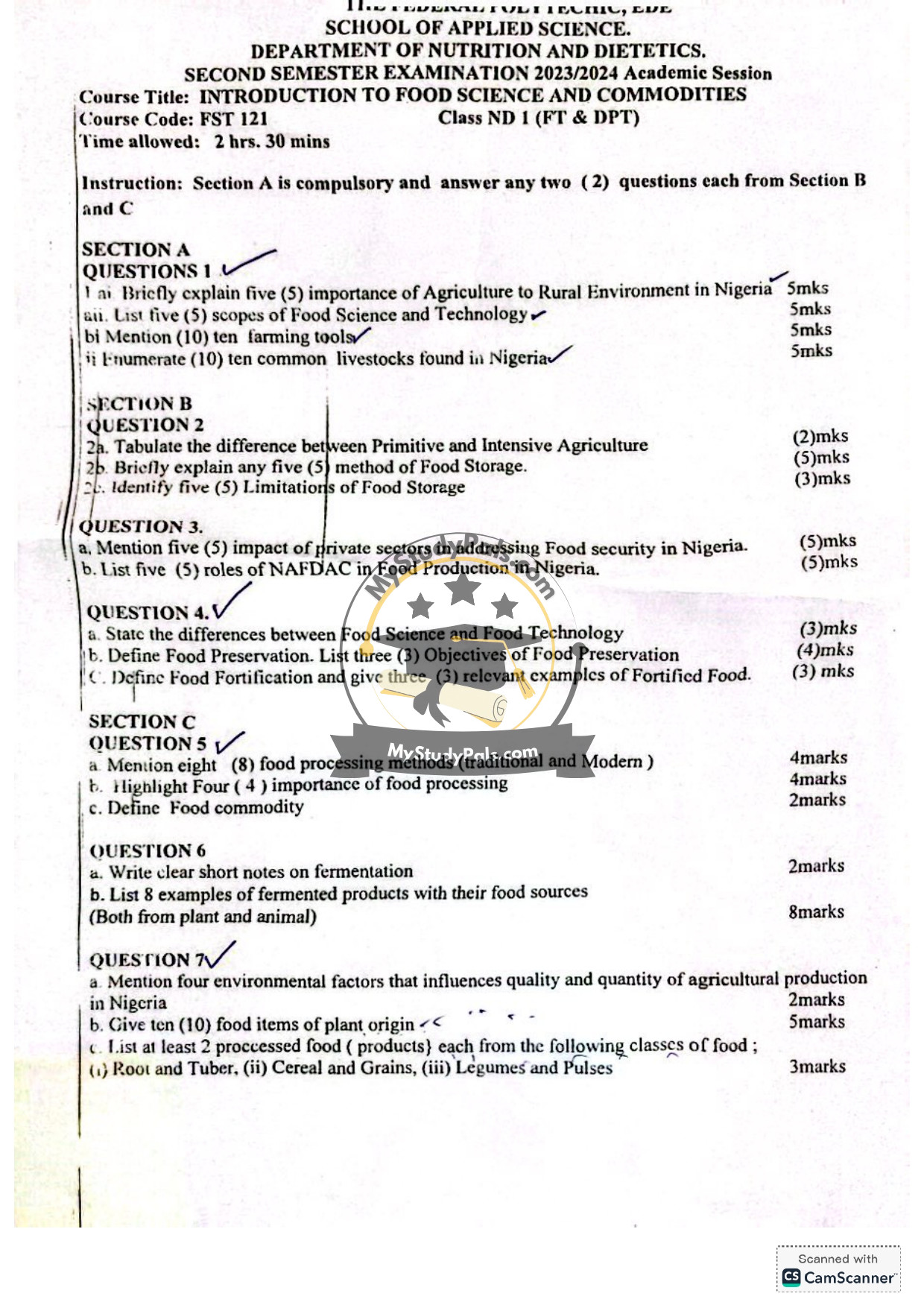ANWSER
Question 1:
a. Briefly explain five (5) importance of Agriculture to Rural Environment in Nigeria:
1. Employment Generation: Agriculture provides jobs for rural populations, reducing unemployment.
2. Income Source: It serves as a primary source of income for rural households.
3. Food Security: Agriculture ensures the availability of food for rural communities.
4. Environmental Sustainability: Farming practices like crop rotation and agroforestry help maintain ecological balance.
5. Infrastructure Development: Agricultural activities often lead to the development of rural infrastructure like roads and markets.
aii. List five (5) scopes of Food Science and Technology:
1. Food Chemistry
2. Food Microbiology
3. Food Processing
4. Food Engineering
5. Food Safety and Quality Control
bi. Mention (10) ten farming tools:
1. Hoe
2. Cutlass
3. Plow
4. Tractor
5. Rake
6. Shovel
7. Wheelbarrow
8. Sprayer
9. Pruning Shears
10. Seed Drill
bii. Enumerate (10) ten common livestock found in Nigeria:
1. Cattle
2. Goats
3. Sheep
4. Poultry (Chickens)
5. Pigs
6. Rabbits
7. Ducks
8. Turkeys
9. Horses
10. Donkeys
—
Question 2:
2a. Tabulate the difference between Primitive and Intensive Agriculture:
| Primitive Agriculture | Intensive Agriculture |
|———————————————–|———————————————–|
| Uses traditional tools like hoes and cutlasses| Uses modern machinery like tractors |
| Low productivity | High productivity |
| Subsistence farming | Commercial farming |
| Relies on natural rainfall | Uses irrigation systems |
| Limited use of fertilizers | Heavy use of fertilizers and pesticides |
2b. Briefly explain any five (5) methods of Food Storage:
1. Refrigeration: Slows down microbial growth by maintaining low temperatures.
2. Canning: Preserves food by sealing it in airtight containers and heating to kill microbes.
3. Drying: Removes moisture to prevent spoilage.
4. Freezing: Preserves food by converting water into ice, inhibiting microbial activity.
5. Fermentation: Uses microorganisms to produce acids or alcohols that preserve food.
2c. Identify five (5) Limitations of Food Storage:
1. High cost of storage facilities.
2. Risk of pest infestation.
3. Energy dependency (e.g., for refrigeration).
4. Limited shelf life for some methods.
5. Loss of nutritional value over time.
—
Question 3:
a. Mention five (5) impact of private sectors in addressing Food security in Nigeria:
1. Investment in agricultural technology.
2. Provision of funding for farmers.
3. Development of storage and processing facilities.
4. Creation of employment opportunities.
5. Promotion of export-oriented agriculture.
b. List five (5) roles of NAFDAC in Food Production in Nigeria:
1. Regulation of food safety standards.
2. Monitoring of food production processes.
3. Certification of food products.
4. Public awareness campaigns on food safety.
5. Enforcement of laws against substandard food products.
—
Question 4:
a. State the differences between Food Science and Food Technology:
– Food Science focuses on the study of food composition, chemistry, and microbiology.
– Food Technology applies scientific principles to the processing, preservation, and packaging of food.
b. Define Food Preservation. List three (3) Objectives of Food Preservation:
– Definition: Food preservation involves treating and handling food to stop or slow down spoilage.
– Objectives:
1. Extend shelf life.
2. Retain nutritional value.
3. Prevent microbial contamination.
c. Define Food Fortification and give three (3) relevant examples of Fortified Food:
– Definition: Food fortification is the addition of nutrients to food to improve its nutritional value.
– Examples:
1. Iodized salt (fortified with iodine).
2. Fortified flour (with iron and B vitamins).
3. Vitamin D-fortified milk.
—
Question 5:
a. Mention eight (8) food processing methods (traditional and Modern):
1. Sun drying
2. Fermentation
3. Smoking
4. Canning
5. Freezing
6. Pasteurization
7. Extrusion
8. Irradiation
b. Highlight Four (4) importance of food processing:
1. Enhances food safety by eliminating pathogens.
2. Extends shelf life.
3. Improves convenience for consumers.
4. Adds value to raw agricultural products.
c. Define Food commodity:
– A food commodity is a raw agricultural product that can be traded or processed, such as grains, meat, or dairy.
—
Question 6:
a. Write clear short notes on fermentation:
Fermentation is a metabolic process where microorganisms like bacteria or yeast convert carbohydrates into acids, alcohols, or gases. It is used to preserve food, enhance flavor, and improve nutritional value.
b. List 8 examples of fermented products with their food sources:
1. Yogurt (Milk)
2. Cheese (Milk)
3. Sauerkraut (Cabbage)
4. Kimchi (Vegetables)
5. Bread (Wheat flour)
6. Beer (Barley)
7. Wine (Grapes)
8. Tempeh (Soybeans)
—
Question 7:
a. Mention four environmental factors that influence quality and quantity of agricultural production in Nigeria:
1. Climate (rainfall, temperature).
2. Soil fertility.
3. Pests and diseases.
4. Water availability.
b. Give ten (10) food items of plant origin:
1. Rice
2. Maize
3. Yam
4. Beans
5. Spinach
6. Tomatoes
7. Bananas
8. Oranges
9. Cassava
10. Groundnuts
c. List at least 2 processed food (products) each from the following classes of food:
– Root and Tuber: Garri, Potato chips
– Cereal and Grains: Bread, Cornflakes
– Legumes and Pulses: Soy milk, Bean flour
—
Question Five (from second image):
5a. What is acid-base balance?
– Acid-base balance refers to the regulation of hydrogen ion concentration in body fluids to maintain a stable pH level (around 7.4 in blood).
b. Give four examples each of acid and base:
– Acids: Hydrochloric acid, Citric acid, Lactic acid, Acetic acid.
– Bases: Sodium hydroxide, Ammonia, Baking soda, Magnesium hydroxide.
c. State five functions hormones perform in the human body:
1. Regulate metabolism.
2. Control growth and development.
3. Maintain electrolyte balance.
4. Influence mood and behavior.
5. Regulate reproductive processes.
d. Explain briefly extracellular fluid composition:
– Extracellular fluid (ECF) includes fluids outside cells, such as plasma and interstitial fluid. It contains high concentrations of sodium, chloride, and bicarbonate, and plays a role in nutrient transport and waste removal.
—
Question Six (from second image):
ai. What do you understand by electrolyte?
– Electrolytes are minerals in body fluids that carry an electric charge and are essential for nerve and muscle function, hydration, and pH balance.
aii. Give six examples of electrolyte:
1. Sodium
2. Potassium
3. Calcium
4. Magnesium
5. Chloride
6. Bicarbonate
b. State three major functions of Atrial Natriuretic Peptide (ANP):
1. Regulates blood pressure by promoting sodium excretion.
2. Reduces water retention.
3. Lowers blood volume.
c. Explain briefly intracellular fluid composition:
– Intracellular fluid (ICF) is the fluid inside cells, containing high levels of potassium, magnesium, and phosphate. It is crucial for cellular metabolism and maintaining cell structure.



